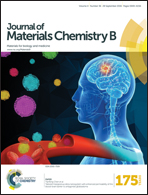Highly selective ratiometric peptide-based chemosensors for zinc ions and applications in living cell imaging: a study for reasonable structure design†
Abstract
Recently, fluorescent peptide-based chemosensors have been reported and used to detect series of metal ions in both aqueous solutions and living cells. In order to explore and indicate the structural regulations of “fluorophore-(His)n-Pro-Gly-(His)n-fluorophore (H2L peptide sensor)”, we predict the relationship between the number of histidine molecules and the coordination activity, as well as the preferred coordination site, through computational studies. Ln=3 was modeled as showing the highest activity with the lowest calculated ΔEtotal, and inner histidine residues bonding with the “Pro-Gly” core structure always provided essential coordination sites for zinc ions. A predicted structural regulation mechanism was studied and verified experimentally. Three Zn2+ sensors with the number of histidine molecules set as 2 (Ln=2), 3 (Ln=3) and 4 (Ln=4) were synthesized and tested. The Ln=3 sensor shows the highest fluorescence intensity by specific binding with Zn2+. The key coordination site was identified by mutating the histidine residues of the Ln=3 sensor. The inner histidine bonding with the “Pro-Gly” core structure was proved as the vital coordination site, and at least one extra histidine had to be provided to assist the coordination process according to the experimental results. Both computational and experimental studies reveal the same relationship between the structure and activity for H2L peptides in the fluorescent sensing of zinc ions. The results give fundamental information for the reasonable design and optimization of all similar classes of peptide sensors.


 Please wait while we load your content...
Please wait while we load your content...